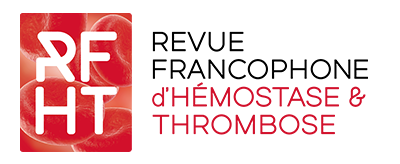RÉSUMÉ
Les plaquettes interviennent dans l’hémostase en interaction avec la paroi vasculaire et certains facteurs plasmatiques. L’adhérence des plaquettes au sous-endothélium et la formation du clou hémostatique font intervenir des glycoprotéines (GP) plaquettaires exprimées à la surface des plaquettes. Plus de 40 glycoprotéines de ce type ont été identifiées. Les trois complexes glycoprotéiques les plus abondants et spécifiques des plaquettes et des mégacaryocytes matures sont GPIIbIIIa, GPIaIIa et GPIbIX, qui portent la majorité des antigènes plaquettaires connus, nommés HPA (Human Platelet Antigen). D’autres glycoprotéines, également présentes à la surface des plaquettes (CD36, CD109), sont impliquées dans l’immunisation antiplaquettaire.
MOTS CLÉS
antigène HPA, glycoprotéine, hémostase, plaquettes
ABSTRACT
Platelets are involved in hemostasis by interacting with the vascular wall and adhesive proteins present in plasma. Platelet adhesion to the subendothelium and the formation of the hemostatic plug involves platelet glycoproteins (GP) expressed on the platelet surface. More than 40 such glycoproteins have been identified. The three most abundant platelet and megakaryocyte-specific glycoprotein complexes are GPIIbIIIa, GPIaIIa and GPIbIX, which carry the majority of platelet antigens called HPA (Human Platelet Antigen). Some other glycoproteins, also present on the platelet surface (CD36, CD109), are involved in anti-platelet immunizations.
KEYWORDS
glycoprotein, hemostasis, Human Platelet Antigen, integrin, platelets

